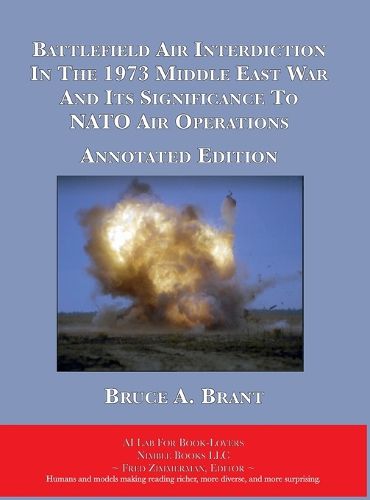Readings Newsletter
Become a Readings Member to make your shopping experience even easier.
Sign in or sign up for free!
You’re not far away from qualifying for FREE standard shipping within Australia
You’ve qualified for FREE standard shipping within Australia
The cart is loading…






The airpower debate continues to rage. Some assert that air superiority has become a relic of the past, a casualty of the proliferation of anti-aircraft missiles, advanced electronic countermeasures, and sophisticated ground-based defenses. Others argue that airpower remains essential to military success, especially in the modern battlefield. And yet, despite the heated rhetoric, few examples of the effective use of airpower in a challenging air defense environment have been available for analysis.
This crucial 1986 thesis, "Battlefield Air Interdiction in the 1973 Middle East War and Its Significance to NATO Air Operations," provides a unique and thorough examination of the use of battlefield air interdiction (BAI) during a conflict of high strategic importance. The document meticulously examines the 1973 Middle East War, a key historical turning point that saw the introduction of new technology and tactics. Major Brant draws on a wide range of sources, including firsthand accounts, classified reports, and insightful analyses of combat data. His comprehensive analysis of the Israeli Air Force's (IAF) use of BAI during the 1973 War sheds new light on the effectiveness of BAI as a method of targeting the enemy's forces, logistical networks, and supplies before they can be brought to bear on the battlefield. The author then deftly connects his findings to the NATO environment, providing a valuable comparative analysis of the key similarities and differences between the Middle East theater and Central Europe. He meticulously accounts for terrain, human habitation, weather, distance, and the evolution of tactics, offering a detailed understanding of the complexities that airpower must contend with in a NATO scenario.
Brant also examines the technological developments that have emerged since 1973, including the proliferation of unmanned aerial vehicles, stand-off weapons, and the rise of airborne early warning and control systems. This thesis, a must-read for researchers, military professionals, and policymakers, offers a fresh and invaluable perspective on the critical role of airpower in future conflicts.
Brant's thorough analysis of the 1973 Middle East War, bolstered by detailed combat data and a deep understanding of the evolving technologies and tactics, provides a unique and timely contribution to the discourse. Readers will gain a sophisticated grasp of BAI and its relevance to current and future military operations.
Bonus: executive summary by foundation-model AI using deep research strategies - otherwise $200/month!
$9.00 standard shipping within Australia
FREE standard shipping within Australia for orders over $100.00
Express & International shipping calculated at checkout
The airpower debate continues to rage. Some assert that air superiority has become a relic of the past, a casualty of the proliferation of anti-aircraft missiles, advanced electronic countermeasures, and sophisticated ground-based defenses. Others argue that airpower remains essential to military success, especially in the modern battlefield. And yet, despite the heated rhetoric, few examples of the effective use of airpower in a challenging air defense environment have been available for analysis.
This crucial 1986 thesis, "Battlefield Air Interdiction in the 1973 Middle East War and Its Significance to NATO Air Operations," provides a unique and thorough examination of the use of battlefield air interdiction (BAI) during a conflict of high strategic importance. The document meticulously examines the 1973 Middle East War, a key historical turning point that saw the introduction of new technology and tactics. Major Brant draws on a wide range of sources, including firsthand accounts, classified reports, and insightful analyses of combat data. His comprehensive analysis of the Israeli Air Force's (IAF) use of BAI during the 1973 War sheds new light on the effectiveness of BAI as a method of targeting the enemy's forces, logistical networks, and supplies before they can be brought to bear on the battlefield. The author then deftly connects his findings to the NATO environment, providing a valuable comparative analysis of the key similarities and differences between the Middle East theater and Central Europe. He meticulously accounts for terrain, human habitation, weather, distance, and the evolution of tactics, offering a detailed understanding of the complexities that airpower must contend with in a NATO scenario.
Brant also examines the technological developments that have emerged since 1973, including the proliferation of unmanned aerial vehicles, stand-off weapons, and the rise of airborne early warning and control systems. This thesis, a must-read for researchers, military professionals, and policymakers, offers a fresh and invaluable perspective on the critical role of airpower in future conflicts.
Brant's thorough analysis of the 1973 Middle East War, bolstered by detailed combat data and a deep understanding of the evolving technologies and tactics, provides a unique and timely contribution to the discourse. Readers will gain a sophisticated grasp of BAI and its relevance to current and future military operations.
Bonus: executive summary by foundation-model AI using deep research strategies - otherwise $200/month!